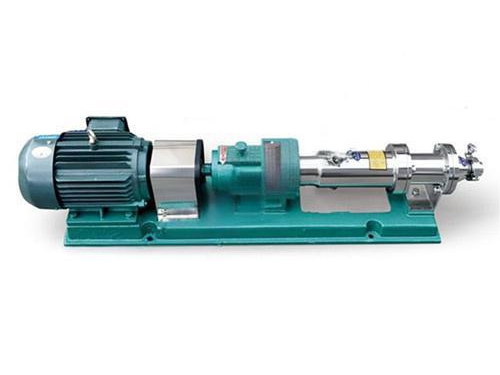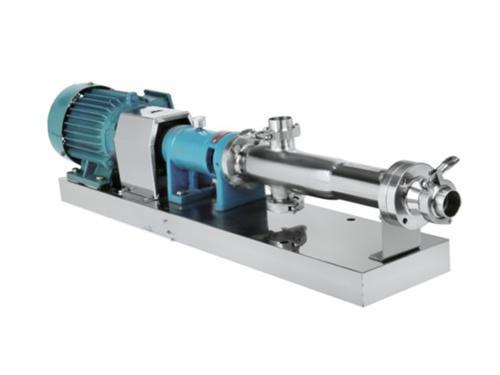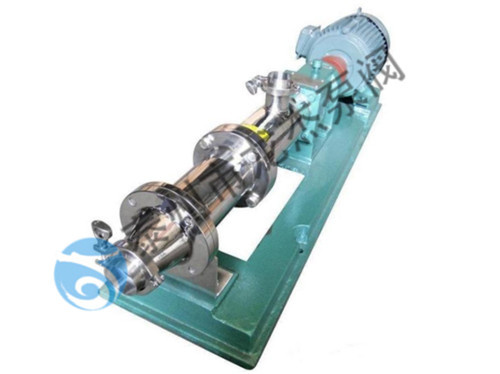
I. Description of the Stainless Steel Screw Pump (Sanitary Grade)
The stainless steel screw pump is a new type of pump operating on the rotary meshing positive displacement principle. Its main working components are an eccentric screw (rotor) and a fixed sleeve (stator).
Due to the unique geometry of these two components, they form separate sealed chambers. The medium flows uniformly in the axial direction, resulting in low internal velocity, constant volume, and stable pressure, thus eliminating vortexes and agitation. Each stage of the pump has an output pressure of 0.6 MPa and a head of 60 m (for clean water). It is suitable for conveying media temperatures below 80°C (up to 150°C for special requirements).
Because the stator is made of a variety of elastic materials, this pump has the unique ability to transport high-viscosity fluids, media containing hard, suspended particles, or fibers, which are beyond the capabilities of conventional pumps. Its flow rate is proportional to the rotational speed.
The drive can be direct via a coupling or variable speed via a variable speed motor, V-belt, or gearbox. This type of pump has few parts, compact structure, small size and easy maintenance. The rotor and stator are the wearing parts of this pump, which have simple structure and are easy to assemble and disassemble.

Advantages of Stainless Steel Screw Pumps:
1) Wide pressure and flow range. Pressure ranges from approximately 3.4 to 340 kgf/cm2, with flow rates up to 18,600 cm3/min;
2) A wide range of liquid types and viscosities can be transported;
3) Because the rotating components within the pump have low inertia, high rotational speeds can be used;
4) Excellent suction performance and self-priming capability;
5) Uniform and continuous flow, low vibration, and low noise;
6) Less sensitive to incoming gas and contaminants than other rotary pumps;
7) Sturdy construction and easy installation and maintenance.
Disadvantages of stainless steel screw pumps include the high processing and assembly requirements for the screw, and the pump's performance is sensitive to changes in liquid viscosity.

III. Stainless Steel Screw Pump Structure:
It primarily consists of a bushing (pump cylinder) fixed to the pump body, a driving screw inserted into the cylinder, and two meshing driven screws. These three meshing screws form a sealed chamber within the cylinder for each lead, creating a seal between the suction and discharge ports.
During operation, because the two driven screws mesh symmetrically with the driving screw, the radial forces acting on the driving screw are completely balanced, and the driving screw experiences no bending load. The radial forces acting on the driven screw are supported along its entire length by the cylinder bushing, eliminating the need for separate bearings at the outer ends and essentially eliminating bending loads. During operation, an oil film forms between the screw's outer surface and the cylinder's inner wall, preventing direct metal-to-metal contact and significantly reducing wear on the screw teeth.
During operation, the stainless steel single screw pump experiences suction and discharge pressures at both ends, generating axial thrust on the screw. For small pumps with a pressure differential of less than 10 kgf/cm2, thrust bearings can be used. Furthermore, high-pressure oil is introduced through the central oil hole of the active screw to the bottom of each screw sleeve, generating a balancing thrust at the lower end of the screw in the opposite direction of the axial thrust.
Like other positive displacement pumps, when the discharge port of a screw pump is completely closed, the pressure within the pump can rise to a dangerous level, potentially damaging the pump or overloading the motor. Therefore, a safety valve must be installed at the pump's suction and discharge ports.
The shaft seal for stainless steel single screw pumps is typically a mechanical seal, and different types can be used depending on the operating pressure.

IV. Working Principle of Stainless Steel Screw Pumps:
Stainless steel screw pumps use the rotation of the screw to draw in and out liquid. Due to the meshing of the screws and the tight fit between the screws and the inner wall of the liner, one or more sealed spaces are created between the pump's intake and discharge ports. As the screws rotate and mesh, these sealed spaces continuously form at the pump's intake end, enclosing the liquid in the intake chamber. Liquid then continuously moves from the intake chamber along the screw's axial direction to the discharge port, discharging the trapped liquid. This is similar to how a nut is continuously pushed forward as its threads rotate. This is how a vertical screw pump operates. Liquid is drawn in and then enters the sealed space enclosed by the threads and the pump casing. As the active screw rotates, the screw threads compress the sealed volume, increasing the pump pressure and causing it to move axially. Because the screw rotates at a constant speed, the liquid outflow rate is also uniform.
V. Stainless Steel Screw Pump Technical Parameters:
Flow Rate: 0-150 m3/h;
Head: 0-180 m;
Power: 0.75-37 kW;
Speed: 500-960 rpm;
Diameter: 20-135 mm;
Temperature: -15-200°C.

Copyright ? Jiangsu Longjie Pump Manufacturing Co., Ltd.